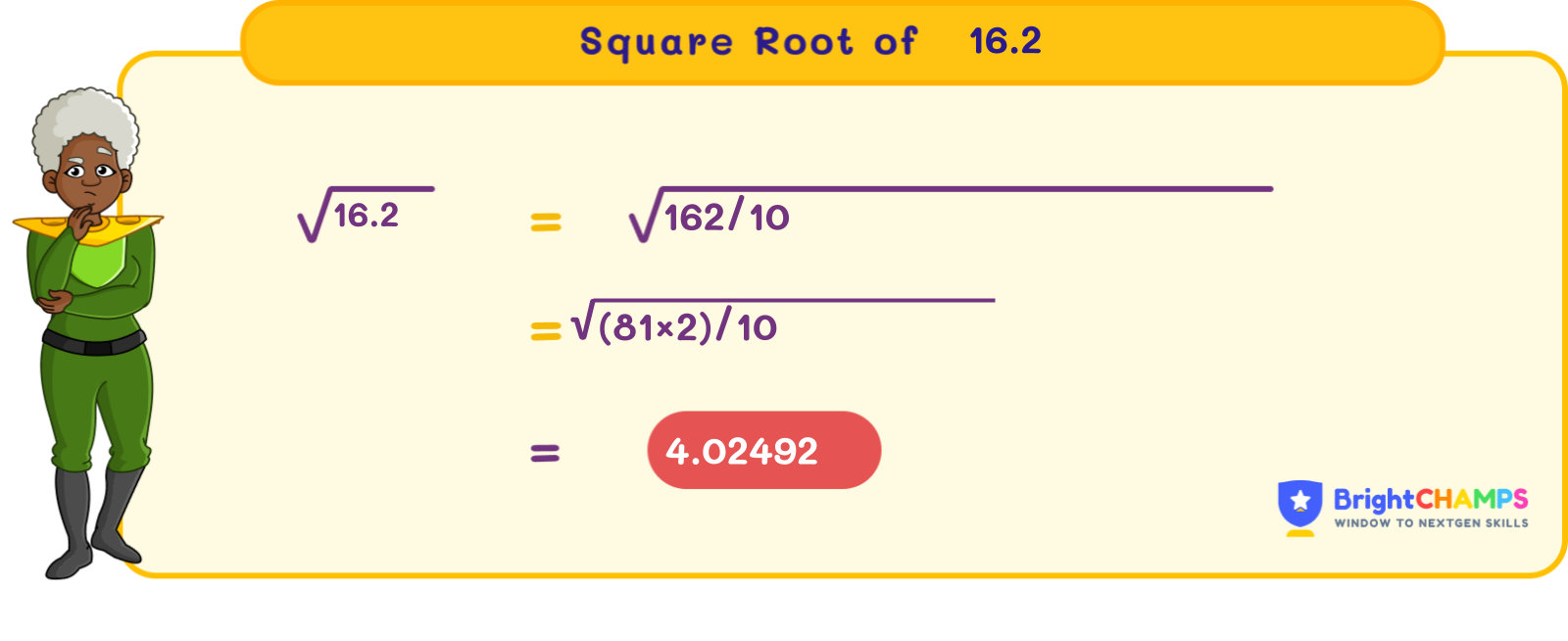![]() Table Of Contents
Table Of Contents

 101 Learners
101 LearnersLast updated on April 8th, 2025

Square Root of 16.2

If a number is multiplied by the same number, the result is a square. The inverse of the square is a square root. The square root is used in the field of vehicle design, finance, etc. Here, we will discuss the square root of 16.2
What is the Square Root of 16.2?
The square root is the inverse of the square of the number. 16.2 is not a perfect square. The square root of 16.2 is expressed in both radical and exponential form. In the radical form, it is expressed as √16.2, whereas (16.2)^(1/2) in the exponential form. √16.2 ≈ 4.0249, which is an irrational number because it cannot be expressed in the form of p/q, where p and q are integers and q ≠ 0.
Finding the Square Root of 16.2
The prime factorization method is used for perfect square numbers. However, the prime factorization method is not used for non-perfect square numbers where long-division method and approximation method are used. Let us now learn the following methods:
- Prime factorization method
- Long division method
- Approximation method
Square Root of 16.2 by Prime Factorization Method
The product of prime factors is the prime factorization of a number. Since 16.2 is not an integer, we cannot directly use prime factorization. However, we can approximate by considering nearby integers. The closest integer factorization would not yield an exact square root, highlighting the need for other methods like long division or approximation.
Square Root of 16.2 by Long Division Method
The long division method is particularly used for non-perfect square numbers. In this method, we should check the closest perfect square number for the given number. Let us now learn how to find the square root using the long division method, step by step.
Step 1: To begin with, consider the number 16.2. Since it's a decimal, multiply by 100 to make it an integer, i.e., 1620.
Step 2: Group the numbers in pairs from right to left. Here, 16 and 20.
Step 3: Find the largest number whose square is less than or equal to 16. It is 4 because 4 x 4 = 16.
Step 4: Subtract 16 from 16, which is 0, and bring down 20.
Step 5: Double the quotient (4), which is 8.
Step 6: Determine a digit x such that 8x multiplied by x is less than or equal to 20. Here, x is 0, making the divisor 80.
Step 7: Subtract 0 from 20 to get 20. Bring down two zeros to make 2000.
Step 8: The process continues, finding the next digits of the quotient.
Step 9: The quotient gives the approximation of the square root of 16.2 as 4.0249.
Square Root of 16.2 by Approximation Method
The approximation method is another method for finding square roots. It is an easy method to find the square root of a given number. Now let us learn how to find the square root of 16.2 using the approximation method.
Step 1: Find the closest perfect squares around 16.2. The closest perfect squares are 16 and 25, so √16.2 falls between 4 and 5.
Step 2: Use interpolation to determine the decimal. Start with (16.2 - 16) / (25 - 16) = 0.2 / 9 ≈ 0.022.
Step 3: Add this decimal to the smaller root: 4 + 0.022 = 4.022.
Thus, the approximation of the square root of 16.2 is around 4.0249.

Common Mistakes and How to Avoid Them in the Square Root of 16.2

Square Root of 16.2 Examples

Problem 1
Can you help Max find the area of a square box if its side length is given as √16.2?

Explanation

Problem 2
A square-shaped building measuring 16.2 square feet is built; if each of the sides is √16.2, what will be the square feet of half of the building?

Explanation

Problem 3
Calculate √16.2 x 5.

Explanation

Problem 4
What will be the square root of (16 + 0.2)?

Explanation

Problem 5
Find the perimeter of the rectangle if its length ‘l’ is √16.2 units and the width ‘w’ is 4 units.

Explanation


FAQ on Square Root of 16.2
1.What is √16.2 in its simplest form?
2.Mention the factors of 16.2.
3.Calculate the square of 16.2.
4.Is 16.2 a prime number?
5.16.2 is divisible by?
Important Glossaries for the Square Root of 16.2
- Square root: A square root is the inverse of a square. Example: 4² = 16, and the inverse of the square is the square root, which is √16 = 4.
- Irrational number: An irrational number is a number that cannot be written in the form of p/q, q is not equal to zero, and p and q are integers.
- Principal square root: A number has both positive and negative square roots; however, the positive square root is often used in practical applications and is known as the principal square root.
- Decimal: A decimal is a number that includes a whole number and a fractional part, separated by a decimal point, such as 7.86, 8.65, and 9.42.
- Long Division Method: A technique used to find the square roots of non-perfect squares by dividing the number into groups and finding successive digits of the square root.
Explore More algebra
 Previous to Square Root of 16.2
Previous to Square Root of 16.2


Jaskaran Singh Saluja
About the Author
Jaskaran Singh Saluja is a math wizard with nearly three years of experience as a math teacher. His expertise is in algebra, so he can make algebra classes interesting by turning tricky equations into simple puzzles.

Fun Fact
: He loves to play the quiz with kids through algebra to make kids love it.




